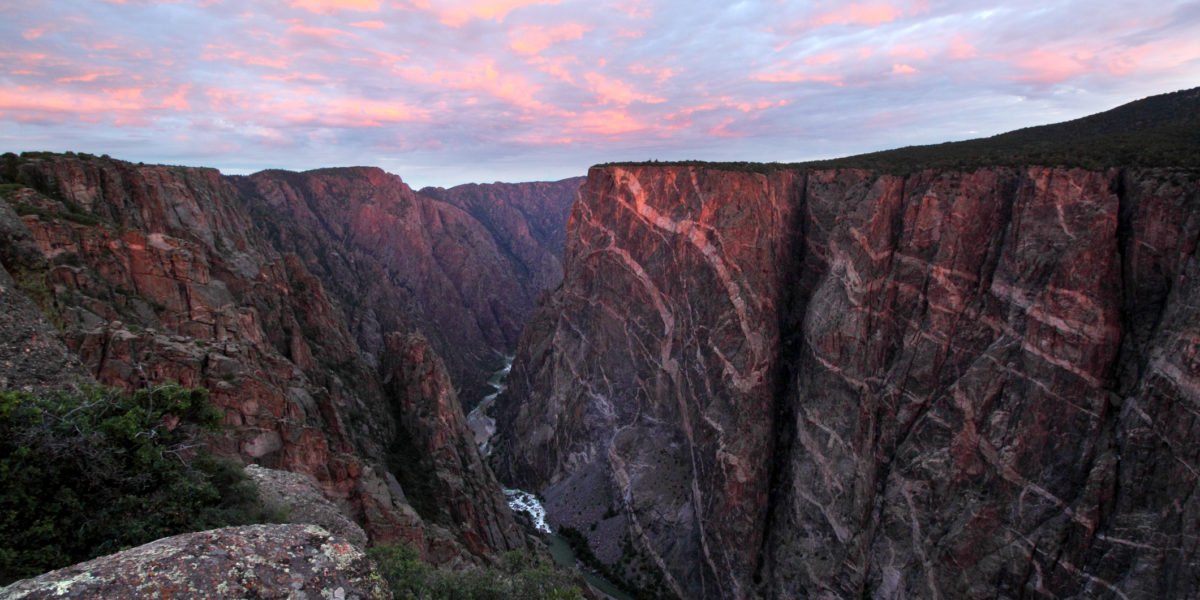
Tired of Crowds? Try These Underrated National Parks Instead
Ditch the long entry lines and camping wait lists.

A total of 63 national parks dot the United States, some inevitably considered more popular than others.
A number of those more attractive destinations have gone as far as implementing entry reservation systems to compensate for overcrowding and the corresponding complications that often result. Yellowstone National Park, for example, saw an inevitable spike of incidents courtesy of those who interpret the Park Service’s many warning signs as mere novelties.
Look no further for outlandish examples than the man who tried to cook chicken in the park’s hydrothermal springs, the ever-growing list of people getting too close to easily frazzled, 2,000-pound bison, or, going back further, the animal experts who put a bison calf in their car because they believed a wild animal that has evolved over millions of years to exist in temperatures 40 degrees below zero was cold. In Joshua Tree National Park, meanwhile, park personnel even went as far as noting that “the park may become drive-through only as the parking lots reach maximum capacity during times of extreme visitation.”
National forests and state parks certainly offer alternatives to the hustle and bustle of major attractions, but there is also a segment of our 63 crown jewels that, stacked up against the more Instagram trend-inspired visits, seldom get their due.
So, in celebration of National Park Week, which runs April 16-24, we compiled a list our favorite such parks that, next to destinations like Yellowstone, Arches, Glacier, Grand Canyon, Zion, or Yosemite, remain inexplicably overlooked and underrated.
Ditch the long entry lines and camping wait lists. Try these instead. (And if you’re looking for more travel inspiration, be sure to sign up for our Travel newsletter here.)
Black Canyon of the Gunnison, Colorado
First-time tourists of Colorado are likely to hit Rocky Mountain National Park or the Great Sand Dunes, but west of these destinations, just outside the town of Montrose, is an attraction often overlooked by visitors of the Centennial State.
With a deepest point of 2,722 feet, the Black Canyon is an intimidating feature cut by the thunderous Gunnison River. The canyon spans 48 miles, 14 of which are inside the national park, and comprises some of the oldest rock on the continent. A network of hiking trails, for those without an aversion to heights, run down into the canyon, as well as along the rims.
The area was certified in 2015 as an International Dark Sky Park, so whether you’re visiting during the day or going for a hike under a starlit sky, there will be no shortage of sights. Plan your visit here.
Canyonlands National Park, Utah
The neighboring Arches National Park might get all the love—and insane crowds—but this other gem just outside Moab, Utah, packs just as much, if not more, of a sightseeing punch.
At more than four times the size of Arches, Canyonlands, another dark sky haven, is a Martian landscape of reddish spires, arches, canyons, mesas, and buttes, landscapes sculpted over millions of years by weather systems and the rivers that form the watery veins of the park. Canyonlands offers four unique districts: The Needles, the Maze, Island in the Sky, and the Rivers.
Getting to one district from another, however, can take some time given the area’s natural rock and water blockades. So, to truly explore the park’s land-bound adventures and rich Indigenous history, plan on visiting for at least a couple days. Or, if rafting is more your speed, multi-day flatwater trips on the Green or Colorado rivers, or whitewater adventures in Cataract Canyon, offer unforgettable experiences. Plan your visit here.
Great Basin National Park, Nevada
In eastern Nevada, west of the Utah border, is a diverse destination that boasts a grove of some of the oldest non-clonal trees in the world—the Great Basin Bristlecone pines.
Twisted by high winds and withstanding temperatures that drop well below freezing, the otherworldly Bristlecones alone make Great Basin a worthwhile trip. Wildlife, including bighorn sheep, subterranean marble caves, and stunning dark skies don’t hurt either.
Dozens of miles of hiking trails are available, as are fishing, stargazing, and camping opportunities. Those looking for more intense adventure can set out to summit the 13,063-foot Wheeler Peak, the tallest peak in Nevada. Plan your visit here.
Guadalupe Mountains National Park, Texas
Near the western edge of Texas and just south of the New Mexico border and Carlsbad Caverns National Park is an 86,000-acre plot known for the 3,000-foot Guadalupe Mountains that jut out from the surrounding Chihuahuan Desert floor.
In that range is the aptly named Guadalupe Peak, Texas’ highest summit at 8,751 feet above sea level. The peak can be reached via arduous trails layered with intense elevation gain, but the view of the expansive desert floor below is more than worth the journey.
Wildlife and plantlife are diverse here, as are the landscapes each species calls home. Limestone rock faces give way to fields of wildflowers and gypsum and quartzose dunes, and the ancient 400-mile-long fossil reef complex, the Captain Reef, is brimming with cultural history, from early Native Americans to Spanish explorers and pioneers of Western expansion. Plan your visit here.
Lassen Volcanic National Park, California
Hydrothermal sites are abundant in this northern Californian landscape of bubbling mud pots, lava fields, and the sort of intricate wilderness only volcanic activity can inspire.
Lush areas surrounding Lassen’s volcanic geology are dotted by mountain lakes and wildflower meadows—more than 700 flowering plant species have been documented here—that make up the habitats of numerous insects and approximately 250 vertebrates.
Sitting at a crossroads with the Cascades to its north, the Sierra Nevada range to its south, and the Great Basin desert to the east, Lassen Volcanic National Park is an ever-evolving and extraordinary result of chaotic environmental influences. Plan your visit here.
North Cascades National Park, Washington
Visitors to the Pacific Northwest may be quick to see Mount Rainier or Olympic national parks, but the stunning North Cascades National Park, which sits less than three hours northeast of Seattle, is often further down the to-do list. (It shouldn’t be.)
More than 300 glaciers can be found in this rugged destination flanked by temperate rainforests to its west and dry ponderosa pines to its east, conditions that make the region especially sensitive to a rapidly changing climate.
Alpine wilderness, evergreen forests, lakes with mountainous backdrops, waterfalls, wildlife, over 1,600 types of plants, and even one of the last operating fire tower lookouts can also be enjoyed here—some from a distance. Pencil this one in ahead of your next PNW adventure. Plan your visit here.
Petrified Forest National Park, Arizona
Given its dearth of forestry today, the name for this northeastern Arizona gem really doesn’t seem to do it justice. Still, the renowned petrified logs, once part of an ancient tropical forest before they were felled by river systems millions of years ago, are a sight to behold. Iron, carbon, and manganese has, over time, transformed these titanic sections of wood into color-rich quartz, but the sights surrounding them are just as impressive.
Badlands, buttes, and mesas house fossils, petroglyphs, wildflowers, and collections of wildlife, and offer all manner of mountain biking, camping, and hiking opportunities.
Hiking trails are, for the most part, family-friendly, and are highlighted by the gradient reds, pinks, and oranges of the Painted Desert. Plan your visit here.
Saguaro National Park, Arizona
For those of us who didn’t grow up in the American Southwest, the desert regions of this country were, at least when we were at a young age, often associated with iconic imagery of the Saguaro cactus.
Nowhere are these magnificent species more abundant—in number and size—than Saguaro National Park. Flanking Tucson, Arizona, to the east and west, the park offers the quintessential desert experience. Approximately two million of the park’s namesake cacti can be found here, with many towering to heights of 40 to 50 feet by the time they reach about 200 years old.
The park is a landscape rich in ancient human history, wildlife, plant life, sparkling night skies, and recreational opportunities, so come eager to explore. Plan your visit here.
Wrangell-St. Elias National Park, Alaska
America’s biggest national park boasts more than 13 million acres, or, as the Park Service notes, the equivalent of “Yellowstone National Park, Yosemite National Park, and Switzerland combined.”
Four major mountain ranges converge on this Alaskan jewel. The park’s mountains account for nine of the 16 tallest peaks in the U.S., including Mt. St. Elias, which, at 18,008 feet, stands as the second tallest peak in the country.
Joined by the same ranges as the Yukon’s Kluane National Park, it is a wilderness seemingly without end. Glaciers, subpolar icefields, ice caves, river systems, and forests offer sights and sounds that can impress even the most cynical. (The Malaspina Glacier, for example, is larger than the entire state of Rhode Island.) If you’ve got an Alaska trip planned in the future, you won’t be disappointed by adding this park to your itinerary. Plan your visit here.
Read the Current Issue Here!
Get one year of Sunset—and all kinds of bonuses—for just $24.95. Subscribe now!
